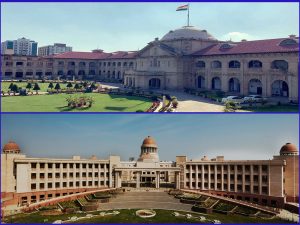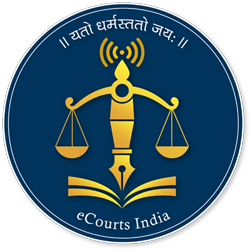Allahabad High Court

High Court of Judicature at Allahabad
The Indian High Courts Act 1861 established High Courts of Calcutta, Madras and Bombay in the year 1862. It vested power in the Queen of England to issue Letters Patent to establish other High Courts like the High Courts of the Presidency Towns with similar powers. In exercise of this power, a High Court of Judicature for the North Western Provinces at Agra was established on 17 March 1866 replacing the Sadr Diwani Adalat. Sir Walter Morgan, Barrister-at-Law was appointed the first Chief Justice of the High Court of North Western Provinces. In the year 1869, it was shifted to Allahabad. By a supplementary Letters Patent dated 11 March 1919, it’s nomenclature was changed to “the High Court of Judicature at Allahabad”. The Oudh Act,1925 Courts (United Provinces Act IV of 1925) was passed by the United Provinces Legislature with the sanction of the Governor-General. It abolished the earlier Oudh Courts Act, and established a Chief Court for Oudh, with 5 Judges: one Chief Judge and 4 puisne Judges. The United Provinces High Court (Amalgamation) Order, 1948, issued by the Governor-General under Section 229 of the Government of India Act, 1935, amalgamated the Chief Court for Oudh with ‘the High Court of Judicature at Allahabad’, initially with six Judges. 
The High Court of Judicature for North Western provinces began its function from a building in Agra and was later shifted to Allahabad in 1869. Sir Walter Morgan was the first Chief Justice, Shri Shah Mohammad Suleman, the first Indian Chief Justice and Shri Bidhu Bhushan Malik was the first Chief Justice after Independence. The foundation stone of the present building of the High Court was laid in 1911 by Sir John Stanley, the then Chief Justice. The construction of the building started in the year 1914 and was completed in 1916. On 27 November 1916 the court was shifted to the present building. In January 2019, 30 Court Room building with modern facilities was made functional. Presently, there are Court 91 Rooms and 96 Chambers besides the Court and the Chamber of the Hon’ble the Chief Justice. A museum was established on a permanent basis, during the High Court’s Centenary celebrations held in 1966, making it the first High Court to have its own museum. The Museum is having a rich collection of Judgments, deeds, photographs, dress, furniture and the original charter of Her Majesty the Queen Victoria of 17 March 1866 by which the High Court was created and established.
In keeping pace with the time, separate building for digitiza tion of records, known as the Center for Information Technology was started March 2016 and stands out as one of the most impressive and modern state-of the-art Information Technology building Country. The court maintains a permanent bench at Lucknow, the administrative capital of the State. A new High Court building has been constructed at Gomti Nagar, Lucknow on 40 acres land, in which there are 57 Court Rooms and is equipped with all modern facilities. As on 14 February 2023, against the strength of 160 Judges, the working strength is of 100 Judges.
tion of records, known as the Center for Information Technology was started March 2016 and stands out as one of the most impressive and modern state-of the-art Information Technology building Country. The court maintains a permanent bench at Lucknow, the administrative capital of the State. A new High Court building has been constructed at Gomti Nagar, Lucknow on 40 acres land, in which there are 57 Court Rooms and is equipped with all modern facilities. As on 14 February 2023, against the strength of 160 Judges, the working strength is of 100 Judges.
E-Initiatives
- eCourt project reports/ statistics High Court Allahabad
- Best practices of the High Court
- Digitization of court records: One Crore decided case files containing approx. 50 Crore pages..More
- Best practices of the District Court
-
- A web based eservices module was developed for ensuring efficient, effective, and user friendly web based integrated…More
-
- Information Technology / Computerization Committee, Allahabad High Court
- Status of the eCourt projects
- e-Initiatives of the eCourt Project
- e-Initiatives of the High Court Allahabad
- e-Initiatives of the District Court




